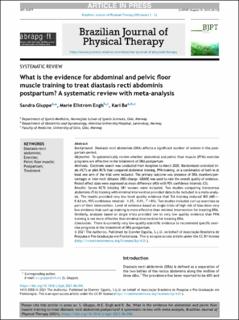| dc.contributor.author | Gluppe, Sandra Lødeng | |
| dc.contributor.author | Engh, Anna Marie Ellström | |
| dc.contributor.author | Bø, Kari | |
| dc.date.accessioned | 2021-12-10T12:53:12Z | |
| dc.date.available | 2021-12-10T12:53:12Z | |
| dc.date.created | 2021-09-01T13:49:25Z | |
| dc.date.issued | 2021 | |
| dc.identifier.citation | Brazilian Journal of Physical Therapy. 2021, Artikkel 06. | en_US |
| dc.identifier.issn | 1413-3555 | |
| dc.identifier.uri | https://hdl.handle.net/11250/2833815 | |
| dc.description | This is an open access article under the CC BY license (http://creativecommons.org/licenses/by/4.0/). | en_US |
| dc.description.abstract | Background: Diastasis recti abdominis (DRA) affects a significant number of women in the postpartum period.
Objective: To systematically review whether abdominal and pelvic floor muscle (PFM) exercise programs are effective in the treatment of DRA postpartum.
Methods: Electronic search was conducted from inception to March 2020. Randomized controlled trials (RCT) or pilot RCTs that compared abdominal training, PFM training, or a combination of both in at least one arm of the trial were included. The primary outcome was presence of DRA (numbers/percentage) or inter-recti distance (IRD) change. GRADE was used to rate the overall quality of evidence. Pooled effect sizes were expressed as mean difference (MD) with 95% confidence intervals (CI).
Results: Seven RCTs totaling 381 women were included. Two studies comparing transversus abdominis (TrA) training with minimal intervention provided data to be included in a meta-analysis. The results provided very low level quality evidence that TrA training reduced IRD (MD = -0.63 cm, 95% confidence interval: -1.25, -0.01, I2 = 0%). Two studies included curl-up exercises as part of their intervention. Level of evidence based on single trials of high risk of bias show very low evidence that curl-up training is more effective than minimal intervention for treating DRA. Similarly, analyses based on single trials provided low to very low quality evidence that PFM training is not more effective than minimal intervention for treating DRA.
Conclusion: There is currently very low-quality scientific evidence to recommend specific exercise programs in the treatment of DRA postpartum. | en_US |
| dc.language.iso | eng | en_US |
| dc.subject | diastasis recti abdominis | en_US |
| dc.subject | pelvic floor muscle | en_US |
| dc.subject | postpartum | en_US |
| dc.subject | treatment | en_US |
| dc.subject | exercise | en_US |
| dc.title | What is the evidence for abdominal and pelvic floor muscle training to treat diastasis recti abdominis postpartum?: A systematic review with meta-analysis | en_US |
| dc.type | Peer reviewed | en_US |
| dc.type | Journal article | en_US |
| dc.description.version | publishedVersion | en_US |
| dc.rights.holder | © 2021 The Author(s) | en_US |
| dc.source.pagenumber | 12 | en_US |
| dc.source.journal | Brazilian Journal of Physical Therapy | en_US |
| dc.identifier.doi | 10.1016/j.bjpt.2021.06.006 | |
| dc.identifier.cristin | 1930494 | |
| dc.description.localcode | Institutt for idrettsmedisinske fag / Department of Sports Medicine | en_US |
| dc.source.articlenumber | 06 | en_US |
| cristin.ispublished | true | |
| cristin.fulltext | original | |
| cristin.qualitycode | 1 | |
